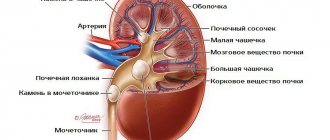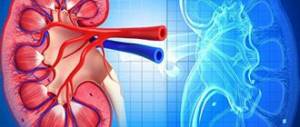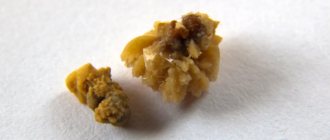Leave a comment 7,845
Sports and exercise are good for health, especially for kidney and back patients. Exercise therapy for pyelonephritis is part of complex treatment and is a necessary factor for a speedy recovery. Before starting exercises, you should definitely consult your doctor. Some physical activities can harm your health and worsen your condition. It is important to pay attention to how you feel when exercising and, if it worsens, stop. Exercises are only permissible in chronic cases of pyelonephritis; in acute cases of the disease, sports are contraindicated.
Therapeutic exercise promotes the overall health of the body, and pyelonephritis is no exception.
The importance and intensity of sports in pyelonephritis
Pyelonephritis is preceded by many other diseases; it does not occur and does not occur on its own. With this pathology, inflammatory processes occur in neighboring internal organs. Along with pyelonephritis, the following diseases are often diagnosed:
- stones in the kidneys;
- hyperplasia;
- malignant prostate tumor;
- renal failure;
- gynecological diseases.
Physical activity is often included in complex therapy in the treatment of many diseases. Exercises for pathology are not only allowed, but also necessary if there are no contraindications. Physical activity quickly brings a sick body back to normal and has a preventive effect on a healthy one.
Pyelonephritis is not an obstacle to playing professional sports.
The doctor must clearly indicate the weekly norm of exercise; excessive exercise has just as bad an effect on the body as its complete absence. First, the patient is recommended to train under the supervision of a trainer, who will indicate a specific set of exercises recommended for pyelonephritis. There are several rules when performing exercise therapy:
- Regularity when playing sports is important;
- exercises should be alternated with rest;
- do each element the required number of times;
- There must be a balance in the loads.
Physical therapy consists of different elements: walking, active games, gymnastics. There are single exercises for pyelonephritis and those where the help of a partner is needed. Classes begin when remission has occurred and the patient feels better. It is worth consulting with your doctor about the possibility of starting sports.
Causes of pain
The causes of pain during exercise can be completely different: a tumor in the kidney or prolapse, thrombosis and atherosclerosis of the renal arteries, cyst, glomerulonephritis and even tuberculosis. This also happens during pregnancy and as a result of varying degrees of injury. In addition, pain while walking can occur with acute appendicitis, prostatitis, or adenoma. Osteochondrosis and hernia are also accompanied by similar pain during movement. And this is not the entire list of causes of pain in the kidney area.
Exercise therapy for kidney inflammation
Therapeutic exercise for pyelonephritis is aimed at eliminating noticeable pain in the lumbar region, as well as general strengthening of the body. Along with exercise therapy, medications and massage treatments are prescribed. When performing therapeutic tasks, you should follow their sequence; they must be performed in a slow and smooth rhythm. If the exercise is accompanied by lower back pain, you need to stop doing gymnastics or reduce the amount.
Exercises on the floor
There are several types of tasks that should be performed while lying on the floor. In the starting position, lie on your back, legs should be spread as wide as possible, while bending them slightly at the knees. Before starting, take a deep breath and exhale several times, which promotes relaxation. When performing the first task, you should join your feet and move your legs at the knees. While inhaling, lower your knees to the right, and as you exhale, return your legs to the starting position. With the next smooth inhalation, lower your knees to the left, then exhale and return them back. It is recommended to do the exercise 12 approaches in each direction. After this exercise, return to the starting position with your legs spread wide. Bend your arms and lean on your elbows, lift your pelvis while taking a deep breath, and lower it as you exhale. It is necessary to perform 5 approaches. If pain occurs, then exclude this exercise or do not lift your pelvis too high.
A physical exercise routine performed on the floor will have a beneficial effect on blood circulation in the kidneys.
To perform the exercise, you will need a book or other light object that can be placed on your stomach. As you inhale, raise your stomach, and as you exhale, lower it. Repeat the exercise 8 times. To do the next task, you need to use a machine that creates a soft spacer. It is performed lying on your back, the exercise machine is placed between your legs. The task is to bring your legs together, resisting the simulator. One approach should be done for 3 minutes. While resting, remain on your back with your legs and arms spread out, breathing smoothly and deeply.
In a standing position and with a chair
After the tasks that are performed lying on the floor, the second part of the gymnastics for pyelonephritis follows. For this complex you will need a chair. Place it in the middle of the room and sit down. You should sit on the very edge and rest your hands on the back of the chair. Smoothly lift your pelvis, at first it is recommended to lift it quite a bit, increasing the amplitude each time. The main thing is that it is comfortable to exercise and there is no pain. Patients with pyelonephritis are recommended to do 8 repetitions.
Read also: The lungs are covered with a serous membrane
You can use additional objects in therapeutic exercises for pyelonephritis.
For the next task, sit completely on a chair, keep your back straight and lean against the back of the chair. Raise your legs bent at the knees one by one as high as possible, you need to reach your chest. Do a total of 6 times on each leg. Sit sideways with your hand on the back of the chair. Lean your back back and hold this position for a couple of seconds, then return to your starting position. During the task, your feet should be firmly on the floor. Complete the task 8 times.
Sit comfortably in the middle of the chair and spread your legs wider. Bend over each leg one by one, trying to reach them. It is important to pause between bends and take the starting position. When you have completed the task, stand up and take a deep breath in and out. The exercise is done standing sideways near a chair, holding onto the back. Alternately move your leg forward, to the side and back. Complete the task 6 times on one leg and the same number on the other.
How I increased my running distance
So, I knocked together a land surveying meter from wooden slats, similar to a large compass. And on the path in the forest plantations I measured different distances: 150 m, 300 m, 600 m.
I started on Monday with 150 m and ran this distance every day. On Saturday I ran twice as much - 300 m. On Sunday I took a break. Starting next Monday, I ran 225 m every day. On Saturday – 450 m. On Sunday, rest again. The next week I ran 300 m. Before the day off I covered 600 m. Then the daily distance increased to 450 m, and the Saturday distance to 900 m.
Three months later, by the end of summer, I was already enjoying the 6-kilometer distance. I’m not writing about pleasure. The fact is that with regular running – and maybe not only running – the human body, according to experts, begins to produce endorphins, which are otherwise called “happiness hormones”. And such a pleasant addiction appears, like we all have - when we see our mother’s cake or our grandmother’s pies.
If after an illness there was a kind of fluttering felt where my heart was, by the fall its measured beating gave me a feeling of self-confidence. Painful sensations in the kidneys when shaking in public transport have stopped.
I ran in any weather. When it rained, I wore a waterproof tracksuit with a hood. I trained after work, that is, after 6-7 pm. Because morning jogging, as shown by many years of research in Japan, leads to leg disease. Sometimes I didn’t run for several days, but quickly returned to training - the memories of my weakness were still strong.
Everyone knows how to breathe when running, you have to think. Inhale through your nose, exhale through your mouth. The running speed should be low, it should allow you to carry on a conversation without being out of breath. Over time, you won’t even notice that the speed has increased much.
What else can you do?
Patients with pyelonephritis should carefully engage in any sports; it is important not to overdo it and not to put a lot of stress on the body. Jogging at a moderate pace, skiing are allowed, and cycling is encouraged. Gymnastics for pyelonephritis should be carried out at a moderate pace, especially if the patient has one organ. If along with the pathology there is a kidney cyst, then jumping and jumping is prohibited. It is recommended to practice hardening, but under the strict supervision of a doctor, so as not to overcool the organs. Thermal baths and saunas have a beneficial effect on the body. But after it you can’t go into a cold shower - a warm one is recommended.
Inflammatory kidney diseases account for half of all lesions of the genitourinary tract. Exercises for pyelonephritis are aimed not only at accelerating recovery, but also at preventing the development of pathologies. Exercise therapy and massage complement basic drug treatment, restore the patient’s immune status and normalize the body’s functioning.
IT IS IMPORTANT TO KNOW! Even “neglected” kidneys can be treated at home, without surgery or injections. Just read what Galina Savina did read more.
Diagnostics
Self-medication should not be practiced for any disease, since without a correct diagnosis, you can only harm your body. This also applies to the treatment of kidney diseases, therefore, when visiting a doctor, each patient must undergo a series of medical examinations, which include the following procedures:
- Taking a general urine test.
- Blood chemistry.
- Get an MRI and CT scan.
- Ultrasound to identify pathologies in organ tissues.
Treatment will be prescribed only after an accurate diagnosis has been established, and may take a sufficient amount of time depending on the complexity of the disease.
If you experience pain in the kidneys when moving, you should definitely consult a specialist and get examined. Self-medication in this case is contraindicated. Share:
Is it possible to play sports with pyelonephritis?
Active sports require a lot of energy. During inflammatory diseases, the main energy of the body is used for the synthesis of antibodies and resistance to the disease; in addition, the cells are severely poisoned by the pathogen and its waste products, which significantly weakens the body. Intense physical stress during pyelonephritis provokes increased pain, slowing down recovery. The possibility of playing sports is decided by the doctor on an individual basis.
Prohibited species
If you have pyelonephritis, you should not engage in exercises that require strong stress on the abdominal muscles. These include weightlifting and powerlifting. Sudden changes in body position, jumping and bending provoke paroxysms of renal colic. Physical activity that causes hypothermia or overheating of the body is strictly contraindicated:
- swimming;
- water aerobics;
- walking or skiing and snowboarding;
- sledding and ice skating.
Return to contents
Permitted species
In the absence of concomitant diseases or other contraindications, cycling, joint exercises, yoga, stretching, long walks or Nordic walking, jogging at an easy pace, table tennis, chess and other sports aimed at obtaining pleasure or even slight relaxation are considered useful.
What to do to prevent runners from having liver problems
- Maintain a gap between meals and physical activity (2 hours)
- Start with warm-up exercises.
- Run with pleasure, at a pleasant pace.
- Maintain the rhythm of breathing.
- Distribute the load evenly.
Sport requires a rational approach. You need to exercise, taking into account the characteristics of your body, and carefully select the appropriate system.
Unfortunately, there are not many practically healthy people in society; it is necessary to focus on all existing diseases and potential risks. Follow your doctor's advice. Moderate exercise is always beneficial.
Exercise therapy program
An integrated approach to treatment necessarily includes exercise therapy, diet and drug therapy for acute pyelonephritis. Objectives of therapeutic gymnastics:
Regularity and systematicity are the key to the effectiveness of exercise therapy.
Gymnastics for pyelonephritis includes warm-up, outdoor sports games, walking elements, yoga and massage. The combination of such exercises, in addition to recovery, is aimed at training the musculoskeletal and cardiovascular systems, preventing possible complications of pyelonephritis:
- nephroptosis;
- chronic form of renal failure;
- ureteral obstruction.
Return to contents
Indications and contraindications
Physical therapy for pyelonephritis is not recommended for all patients. Classes are carried out only when you feel relatively stable and satisfactory. Normal body temperature and the absence of pain are considered prerequisites. You should not engage in physical activity if you have urinary problems. Use caution if you have concomitant diabetes mellitus and arterial hypertension.
Examples of exercises
Exercise therapy exercises for pyelonephritis are performed at a moderate or slow pace. The intensity is selected individually with a subsequent increase in load. The lesson takes up to half an hour. The exercise therapy complex covers:
- preliminary warm-up and warming up of muscles;
- therapeutic gymnast;
- dynamic games;
- diaphragmatic breathing techniques;
- yoga asanas;
- relax.
Return to contents
Exercise on the floor
- From the starting position on your back, bending your knee at the inhalation phase, raise the opposite arm. Exhale, returning to the starting position. Do the same on the other limbs. Repeat 5-10 times.
- Starting position: lying on your back, hands on your waist. During the inhalation phase, raise your head and shoulder girdle from the floor. Exhale. Return to starting position.
- Lying on your left side, extend your left arm up and slightly bend your leg of the same name. As you inhale, raise your right arm and bring your bent right leg to your stomach. Perform 5-10 times. Repeat on the other side.
- Starting position: lying on your left side. Inhale and pull your right knee and arm toward your chest. Straighten up. Perform up to 10 times. Repeat lying on your left side.
- Sitting on the floor with straight legs, bend over to each leg in turn.
- Sitting on the floor, feet shoulder-width apart. Try to reach the toe of your foot with your hand. Repeat 5-10 times in each direction. Stretch forward 5 times, touching the floor.
Read also: Cleanse the lungs and bronchi
Exercise therapy for pyelonephritis can be carried out at home, using a mat and a chair. Return to contents
Standing and sitting
- Sit on a chair, resting your hands on the seat. Raise your pelvis as much as possible.
- Sitting on a chair, pull your leg bent at the knee joint towards your chest.
- Leaning on the back of a chair or table, move your legs to the sides and back.
- Leaning on the back of the chair, bend your knees slightly and perform rotational movements in the hip joint.
- Imitation of walking in place with high kicking of the legs and turns of the body.
Return to contents
Lesson objectives
Exercise therapy for pyelonephritis is performed under the supervision of the attending physician: all exercises must be selected individually, taking into account the specific course of the disease, the presence of contraindications and concomitant pathologies.
The goals of physical therapy for kidney diseases:
- restoration of impaired blood supply through the renal arteries;
- normalization of metabolism in the body;
- reduction of increased pressure due to pyelonephritis, reduction of edema;
- restoration of impaired passage of urine through the urinary tract, relief of spasm.
Gymnastics for prevention
Rehabilitation for pyelonephritis takes place in three stages: gentle, functional and educational. During the first 14 days, exercises are performed in a lying position to improve blood supply to the kidneys. The complex includes training for small and medium-sized muscles and breathing exercises. During the functional stage, general strengthening and specialized loads are added in a sitting or standing position. The training period is aimed at developing the abdominal muscles, the muscular corset of the back, and the genitourinary diaphragm.
To regulate your psycho-emotional mood, use auto-training and breathing techniques.
Morning exercises are added to the functional and training stages. Moderate intensity physical exercises are indicated: Nordic walking, running at a moderate pace, rowing. Muscle relaxation techniques improve renal hemodynamics. The level of load for pyelonephritis is selected in accordance with the degree of physical training and preparedness of the patient, taking into account motor experience.
Features of gymnastics
You can engage in physical therapy when acute symptoms subside. However, even if general weakness and minor pain persist, you can perform breathing exercises. Goals of diaphragmatic breathing for pyelonephritis:
- relaxation of the renal fascia;
- restoration of blood circulation;
- improvement of lymph flow.
Diaphragmatic breathing involves opening the lower ribs as you inhale. This allows the diaphragm to move down to fill the lungs with air. When breathing without expanding the ribs, patients have to hyperextend their lower back and raise their shoulders with each inhalation.
Compressing a nerve for a muscle means it relaxes. A weak iliopsoas muscle stops holding the organ, and it drops, which causes vasospasm.
Principles of conducting
The basic principles of exercise therapy come from the fact that the direction of physical activity is restorative:
- start classes after the inflammatory process subsides;
- use dosed loads, avoid pain;
- exercise 10-15 minutes a day during the first week;
- perform the exercises slowly, without jerking, which is extremely important for the kidneys;
- give up strength loads and static exercises (plank, bridges).
Do you still think that it is difficult to cure your kidneys?
Judging by the fact that you are reading these lines now, victory in the fight against kidney diseases is not yet on your side.
Have you already thought about surgery? This is understandable, because the kidneys are a very important organ, and their proper functioning is the key to health and well-being. Weakness, swelling, loss of appetite, back and lower back pain. All these symptoms are familiar to you firsthand.
But perhaps it would be more correct to treat not the effect, but the cause? We recommend reading the story of Galina Savina, how she cured her kidneys. Read the article >>
The kidneys are one of the most important organs in the body, which, using the filtering function, are able to remove toxins and substances that do not bring any benefit. If the kidneys are inflamed, their performance will be impaired, and a person’s well-being will deteriorate significantly. Therefore, everyone is interested in how to contribute to their recovery and what can be eaten with kidney pyelonephritis?
But the first thing to do is to identify those things that can harm and aggravate the inflammatory process. In this case, it is important to lead a healthy lifestyle and eat right. Do not forget that each form of pathology has its own recommendations. For example, when asked whether it is possible to play sports with pyelonephritis, a person with an acute or chronic degree of the disease will receive a different answer.
What is good for human kidneys
The human body is such a complex system of interacting organs that disruption of the functioning of any of them is fraught with serious and often irreversible consequences. Thanks to the changes that occurred during the process of evolution, man received a certain protection in the form of a paired structure of vital organs. The kidney, being one of these organs, is capable of performing double work in case of loss of the second one.
Despite the enormous load (the kidneys filter more than 180 liters of blood per day), they are a very delicate mechanism that requires careful treatment. In order not to subject the urinary system to excessive stress, it is necessary to know what is good for the human kidneys and what should be avoided.
Principles of healthy eating
The principle of healthy nutrition includes a versatile approach, which consists, on the one hand, of consuming foods that can provide all the necessary needs of the whole body and food that is beneficial directly to the kidneys, and on the other hand, eliminating the negative effects of harmful foods.
Disruption of any body system necessarily affects the functioning of the kidneys. For example, diseases of the digestive tract are closely related to the regulation of protein and salt metabolism, which becomes an indirect cause of the development of urolithiasis.
Therefore, the list of healthy foods should consist of a list of fruits and vegetables rich in microelements, as well as fish and meat products containing essential amino acids. However, it should be remembered that no matter how varied the diet, all products retain all their beneficial substances only if they are steamed, boiled or baked in the oven.
Are there any restrictions for pyelonephritis?
There are restrictions with this pathology, and this is due to the fact that a patient with pyelonephritis can eat and how intense the physical activity can be.
Note! The diet for an acute form of the disease provides for fairly strict conditions for a person. The main goal pursued by doctors in this case is to relieve the patient of pain, adjust the pH of urine and reduce the load on inflamed organs.
If we talk about chronic pyelonephritis, here the restrictions will be more gentle. In this case, you should not lean heavily on water or other drinks, since at the moment the kidneys are not able to provide sufficient urine output. There are also certain recommendations regarding the working conditions in which the patient is located.
In any situation, hypothermia of the back and entire body should not be allowed. It is strictly forbidden to work in places where the wind always blows through. Thus, the question of whether it is possible to warm the kidneys during pyelonephritis will be accompanied by a positive answer, but here it is important not to overdo it, everything should be in moderation.
If you have pyelonephritis, it is not recommended to drink a lot of water 2 hours before bedtime. To rid yourself of the feeling of thirst, experts advise eating half a small pickled cucumber, this will trick the body and allow you to sleep peacefully all night.
Indications for physical therapy
Frequent relapses of inflammation and the chronic form of the disease are the main indications for exercise therapy. Stagnation is often caused by a sedentary lifestyle. The kidneys are directly connected to the blood supply system, which is activated during physical activity.
The organ is affected by breathing, and with prolonged sitting it is depressed due to stooping or incorrect position of the lumbar region.
The main indications for exercise therapy for pyelonephritis:
- prolonged inflammatory process;
- frequent relapses of infection;
- change in kidney size on ultrasound.
What physical limitations are there?
If a patient is wondering whether pyelonephritis can be cured forever, he must learn a few simple rules. Sports that involve hypothermia or heavy strain on muscles should be excluded, at least temporarily. Swimming is such because of the strong load on the abdominal muscles.
But you shouldn’t draw such conclusions on your own. This must be decided by the doctor after conducting the necessary types of research and making a correct diagnosis. The specialist’s decision will also be based on the patient’s age, general clinical picture and well-being.
Read also: How to grow smoking tobacco at home
The most useful activities for pyelonephritis will be the following:
- Race walking.
- Gymnastics.
- A ride on the bicycle.
This kind of sport involves having fun and maintaining physical fitness, which is why it is safe for people with pyelonephritis. In recent years, therapeutic yoga has become very popular. There is also a positive effect here, but the main thing is to properly prepare the body to eliminate the possibility of injury.
What are the benefits of physical therapy?
Physiotherapy exercises are always officially included by doctors in a set of activities that will help the patient cope with the disease as quickly as possible. All exercises are selected individually for a specific situation and are first accompanied by the supervision of a doctor or visits to special groups.
In order for the patient to be allowed to start exercising, his condition must improve, that is, the body temperature is not exceeded, there is no pain and there is no risk of internal bleeding. In this case, the exercises will bring the following benefits:
- increasing the body's ability to resist the inflammatory process;
- reduction of swelling;
- reducing urinary stagnation;
- improvement of psychological state;
- eliminating the possibility of complications;
- normalization of pressure;
- increased performance;
- normalization of the metabolic process;
- restoration of normal blood circulation in the kidneys;
- stimulus for restoration of the endocrine system.
A full range of gymnastic exercises includes massages, outdoor games and walking. This is all used simultaneously with drug therapy. Choosing certain exercises eliminates the possibility of high loads. The lesson takes place at a low or medium pace. In this case, the abdominal muscles are used to a minimum.
Possible Explanations
The study's lead author, Yale nephrologist Dr. Chirag Parikh, suggests there may be a variety of causes for this phenomenon. First of all, a marathon runner's body experiences severe dehydration while running. This condition in itself is a huge burden on the kidneys. Secondly, running increases body temperature. And if you run for two and a half hours, inflammation and muscle breakdown begin. Thirdly, protein levels increase, which puts additional stress on the kidneys. There is one more “but”: the body needs blood to maintain muscle tone, so while running the kidneys remain on a starvation diet.
Are there any dietary restrictions?
If a person is diagnosed with any form of pathology, one of the first questions that interests him is what can he eat if he has pyelonephritis? Most often, doctors use diet No. 7 in this case. It has a positive effect on the human condition and does not harm other organs of all systems. The use of the following products is strictly prohibited:
- Highly concentrated broth based on fatty meat or fish.
- All legumes and mushrooms.
- Cheeses with pungency (salty).
As for foods of plant origin, you will have to temporarily avoid eating sour vegetables, such as capsicums, spinach, radishes, and sorrel. This also includes canned pickles.
If a patient has acute pyelonephritis, he is completely contraindicated from consuming salt in any form, as well as smoked and fatty fish. Other prohibited products include:
- strong tea and coffee;
- high fat sour cream;
- all spices and seasonings;
- confectionery products, including chocolate.
Massotherapy
In combination with rehabilitation physical therapy, massage will also help. There are points on the foot that are responsible for the kidneys. Massaging these areas has a positive effect on the kidneys, improving urine passage.
Back massage is indicated for inflammatory kidney diseases. But it is only contraindicated to knock in the lumbar region, since this aggravates the pathological process, causing pain.
No wonder they say that sport is life. Without movement you will not be healthy. It strengthens the body and improves mood. In combination with medications, it enhances treatment. Be healthy!
Answers on questions
One of the most asked questions is whether pyelonephritis affects life expectancy? The answer sounds much simpler than you might imagine. The disease is not able to influence the time frame in any way. But only if a person promptly goes to the hospital at the first signs of pathology.
Also, the outcome will depend on the inflammatory process in one or two kidneys. To get rid of all risks, you need to adhere to a healthy lifestyle and periodically get tested. This will allow you to get rid of the manifestations of pathologies at an early stage.
How long will the high temperature last? If the disease is in the acute stage, the patient may suffer from an increase in blood pressure within 1 week.
How much water should you drink per day if you have pyelonephritis? In a difficult situation, during an exacerbation, doctors advise drinking as much pure water without gas as possible. Typically the dosage is 2-2.5 liters. You cannot reduce it yourself. This can only be done by a specialist, based on the results of the study.
How long will you have to stay in the hospital? This will depend on the form of the disease, the intensity of symptoms and general well-being. Typically, people with pyelonephritis end up in the hospital for at least 10-15 days.
Is it possible to have sex with pyelonephritis? Until now, no obvious health risks have been found after having sex. Therefore, patients may not sacrifice this for the sake of a speedy recovery.
Is it possible to go to the bathhouse or warm up on your own in other ways if you have pyelonephritis? When the pathology is present in the body in an acute state, the patient is prohibited from visiting the bathhouse, getting very warm, or performing any other actions that involve heating.
In this case, there is a high probability that the patient will experience a deterioration in his general condition. The bath is allowed only in the remission stage. But you cannot make such a decision on your own; this fact must be confirmed by appropriate analyzes.









